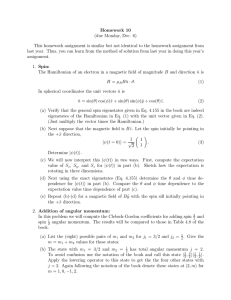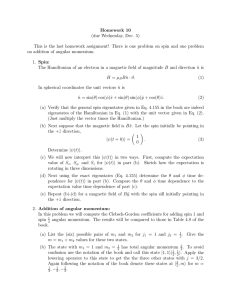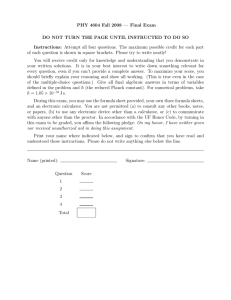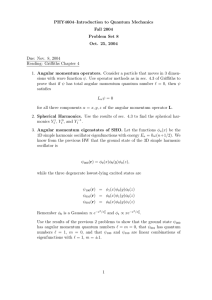VII. Central Potentials
advertisement
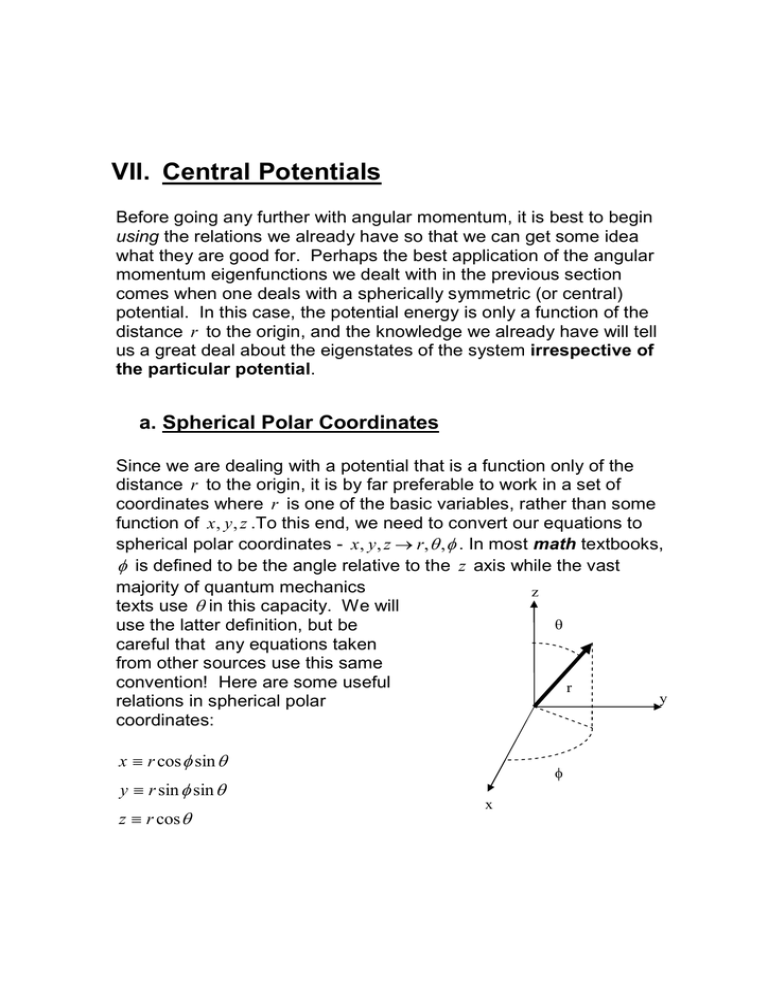
VII. Central Potentials
Before going any further with angular momentum, it is best to begin
using the relations we already have so that we can get some idea
what they are good for. Perhaps the best application of the angular
momentum eigenfunctions we dealt with in the previous section
comes when one deals with a spherically symmetric (or central)
potential. In this case, the potential energy is only a function of the
distance r to the origin, and the knowledge we already have will tell
us a great deal about the eigenstates of the system irrespective of
the particular potential.
a. Spherical Polar Coordinates
Since we are dealing with a potential that is a function only of the
distance r to the origin, it is by far preferable to work in a set of
coordinates where r is one of the basic variables, rather than some
function of x , y , z .To this end, we need to convert our equations to
spherical polar coordinates - x , y , z → r, θ , φ . In most math textbooks,
φ is defined to be the angle relative to the z axis while the vast
majority of quantum mechanics
z
texts use θ in this capacity. We will
θ
use the latter definition, but be
careful that any equations taken
from other sources use this same
convention! Here are some useful
r
y
relations in spherical polar
coordinates:
x ≡ r cos φ sin θ
y ≡ r sin φ sin θ
z ≡ r cos θ
φ
x
e r ≡ cos φ sin θ i + sin φ sin θ j + cos θ k
eθ ≡ cos φ cos θ i + sin φ cos θ j − sin θ k
eφ ≡ − sin φ i + cos φ j
∇ ≡ er
∇2 =
∂
1 ∂
1 ∂
+ eφ
+ eθ
∂r
r sin θ ∂φ
r ∂θ
∂2
∂
∂
1 ∂ 2 ∂
1
1
+
+
r
sin
θ
∂θ
r 2 ∂r ∂r r 2 sin 2 θ ∂φ 2 r 2 sin θ ∂θ
b. Central Potentials
For an arbitrary potential V (r ) , we can write
Hˆ = −
2
∇ 2 + V (rˆ )
2m
At this point, we convert the equations to natural units by choosing
our unit of length and unit of mass so that = m = 1. Note that this
leaves us one free standard unit (time, or, equivalently, energy). It is
convenient to fix this dimension based on the problem at hand; for
example, in a harmonic oscillator, it is useful to choose the energy so
that ω = 1 , while for the Coulomb interaction it is useful to choose the
unit of electron charge to be that of one electron. These units are
merely out of convenience and in the end, once we have calculated
an observable (such as the position) we will need to convert the result
to a set of standard units (such as meters). The main benefit at the
moment is that it removes the relatively unimportant factors of and
m from our equation, so that in natural units:
∇2
−1 ∂ 2 ∂
1 ∂2
1 ∂
∂
ˆ
H =−
+ V (rˆ ) = 2 ( r
+ 2
+
sin θ
) + V (rˆ )
2
2
r ∂r ∂r sin θ ∂φ
sin θ ∂θ
∂θ
where the second equality just reinforces the gory details wrapped up
in the Laplacian operator.
c. Orbital Angular Momentum Operators
In order to see what angular momentum has to do with this, we need
to express the angular momentum operators in spherical polar
coordinates, as well. In this case, the relevant type of angular
momentum is that of the particle orbiting around the origin:
1 ∂
∂
Lˆ = rˆ × pˆ = re r × −i∇ = −i eφ
− eθ
sin θ ∂φ
∂θ
Plugging in our expressions for {eθ , eφ } from above:
∂
1 ∂
Lˆ = −i {− sin φ i + cos φ j} − {cos φ cos θ i + sin φ cos θ j − sin θ k}
∂θ
sin θ ∂φ
= −i − sin φ
∂
∂
∂
∂
∂
− cos φ cot θ
− sin φ cot θ
i − i cos φ
j−i k
∂θ
∂φ
∂θ
∂φ
∂φ
Lˆ x
Lˆ y
Lˆz
Further, after some algebra, one can show
1 ∂2
1 ∂
∂
2
2
2
2
2
ˆ
ˆ
ˆ
ˆ
L = Lx + Ly + Lz = −
+
sin θ
.
2
2
sin θ ∂φ
sin θ ∂θ
∂θ
At this point we notice that L̂2 plays a conspicuous role in the
Hamiltonian:
ˆ2
−1 ∂ 2 ∂ L
Hˆ = 2
r
+ 2 + V (rˆ )
r ∂r ∂r r
Hence, all of the angular dependence of Ĥ is contained in L̂2 and we
immediately conclude that:
Hˆ , Lˆ 2 = 0
Hˆ , Lˆz = 0
[
]
[
]
which means that the eigenfunctions of Ĥ are also angular
momentum eigenfunctions! That is, for any fixed r ,
ψ i ∝ l, m
Eigenfunction
of Hamiltonian
Quantum
Number for Lz
Quantum
Number for L2
Of course, we really want to know what the eigenfunctions look like in
real space rather than writing them as abstract vectors. First of all,
notice that none of the angular momentum operators depend on r ,
and so the eigenfunctions depend only on the angles θ and φ . We
will denote these functions by
Yl m (θ , φ ) ≡ θ , φ l , m
where l indexes the eigenvalue of L̂2 and m indexes the L̂z
eigenvalue. Then, we can write
r, θ , φ ψ i = Rlm (r )Yl m (θ , φ )
The radial function will depend on the form of V ( r ) , but the angular
parts are universal – they are just the spatial representation of the
orbital angular momentum eigenfunctions. They are called spherical
harmonics and we proceed to define their precise form
d. Spherical Harmonics
The eigenvalue equations we derived previously for angular
momentum now become partial differential equations that are not
always easily solved. The L̂z equation is trivial to solve:
LˆzYl m (θ ,φ ) = m Yl m (θ , φ )
−i
∂ m
Yl (θ , φ ) = m Yl m (θ , φ )
∂φ
Yl m (θ , φ ) = Pl m (θ )eimφ
Unfortunately, the equations for Pl m (θ ) are more difficult. To solve for
the Pl m ’s, we follow two steps:
1) Recall that Lˆ+Yl m=l (θ , φ ) = 0. Or, in differential language:
eiφ
∂
∂
Pl m=l (θ )e ilφ = 0
+ ieiφ cot θ
∂θ
∂φ
il
(
∂
− l cotθ ) Pl m=l (θ ) = 0
∂θ
Pl m =l (θ ) ∝ sin l θ
2) Using this simple result for m = l , we can generate the
spherical harmonics for other values of m by repeated
application of the lowering operator:
l −m l
P m (θ ) ∝ Lˆ
P (θ )
( )
−
l
l
The second step is rather tedious, and so we simply state that the
result
2l + 1 (l + m )!
d l− m
l
−m
m
Pl (θ ) = (− 1)
sin θ
sin 2l θ
2
2 l +2
l− m
π 2 (l − m )! (l!)
d cos θ
Yl m (θ , φ ) = (− 1) Pl m (θ )eimφ
m
These are the spherical harmonics and they are the eigenfunctions of
L̂2 and L̂z . The normalization constant has been chosen so that
Yl m* (θ , φ )Yl m' ' (θ , φ )sin θdθ dφ = δ m ,m 'δ l ,l '
that is, we have chosen it so that the spherical harmonics are
orthonormal.
Now, one important constraint on these solutions is that l must be
an integer. To see this, note that half-integer l would imply halfinteger m . In this case we have a problem, because as we seep
around an angle ∆φ = 2π the wavefunction needs to return to its
original value; that is, it needs to be periodic. However, if m is halfinteger, this is not true. For example, if m = 12 ,
e i (φ +2π ) / 2 = eiφ / 2 eiπ = − eiφ / 2 ≠ eiφ / 2
Because the half integer solutions do not obey the proper boundary
conditions, they must be discarded.
Hence, even though our derivation above seemed to indicate that
angular momentum could be half-integer, for the special case of
orbital angular momentum, this is not possible. We will see shortly
that half-integer angular momenta are crucial for the description of
particle spins. In any case, this shows how the general quantization
conditions l = 0, 12 ,1, 23 ... and m = −l ,−l + 1,...l can be even further
restricted when one is dealing with particular types of angular
momentum. We will never have an l that is not an integer or half
integer, but often only certain integer or half integer values will be
permissible.
e. The Radial Equation
Combining our expression for the spherical harmonics with the
previous results, we find that the eigenfunctions for any central
potential can be written
r,θ , φ ψ i = Rlm (r )Pl m (θ )eimφ
that is, the three dimensional wavefunction is separable into a
product of three one dimensional wavefunctions. This is not
generally the case, and is one of the particularly nice properties of
spherically symmetric potentials. The radial function will generally
depend on the form of the potential, but it will obey the equation:
− 1 ∂ 2 ∂ l (l + 1)
r
+
+ V (r ) Rlm (r ) = Ei Rlm (r )
2
2
2r ∂r ∂r
2r
This equation can be solved exactly for only a few cases (the
harmonic oscillator and the Coulomb potential are the most notable).
Notice that the eigenvalue equation depends on the value of l , the
quantum number for L̂2 , but not m , which indicates the projection of
the angular momentum along the z axis. Hence the Rlm ’s do not
actually depend on m . Further, we anticipate the appearance of
another quantum number (call it n ) that indexes the solutions to this
radial equation. Hence, we replace Rlm (r ) → Rnl (r ) in what follows.
The radial equation can be simplified further if we look at the equation
satisfied by the functions ρ nl (r ) ≡ rRnl (r ) :
− 1 ∂ 2 l (l + 1)
+
+ V (r ) ρ nl (r ) = E nl ρ nl (r )
2 ∂r 2
2r 2
where, on the right, we have noted that the energies also depend on
n and l . Notice that resemblance of this equation to the 1D
Schrödinger equation. Indeed, if we define the effective potential by
l (l + 1)
Veff (r ) =
+ V (r )
2r 2
then this is a 1D Schrödinger equation, with the effective potential
above. Note, however, that the boundary conditions are different
than the typical 1D case:
ρ nl (0) = 0
ρ nl (∞ ) = 0
Because the additional term in Veff arises from the angular motion of
the particle around the nucleus, it is usually called the “centrifugal
potential”.
f. Hydrogen-like Atoms
We are now ready to specialize to the particular case of the
hydrogen-like atoms – that is, atomic ions with only one electron (H,
He+, Li+2…). First, we will make the “infinite mass” approximation for
the nucleus - we place the it at the origin and assume it never moves
because it is much more massive than the electron. This is a fairly
good approximation, since m p / me ≈ 1800 , but if one wishes to be
more precise, one merely needs to replace the electron mass with the
−1
reduced mass µ = (m1e + m1N ) in what follows. Hence, the nucleus only
presents a potential in which the electron moves:
Ze 2
V (r ) = −
r
where − e is the charge on the electron and + Ze is the charge of the
nucleus . At this point, we move from “natural units” ( = me = 1 )to
“atomic units” ( = me = e = 1 ). We can now explicitly state our
fundamental units of mass, length and energy:
1 unit of mass = me ≈ 9.11 × 10−28 g
1 unit of length=1 Bohr ≡ a0 =
2
me e
2
≈ 5.29 × 10 −9 m
e2
≈ 4.36 × 10 −18 J
a0
The latter two units give the typical distance an electron is from the
nucleus and a typical energy for an electron in a Coulomb potential.
1 unit of energy=1Hartree ≡ Eh =
Hence, we want to solve the equation
− 1 ∂ 2 l (l + 1) Z
+
−
ρ nl (r ) = Enl ρ nl (r ) .
2 ∂r 2
2r 2
r
Like the equation for Pl m (θ ) , this is fairly tedious to solve, and we
merely outline the steps
1) Notice that for large r , the potential terms vanish and we
just have
ρ nl (r ) ≈ e ± r −2 E
One must take the ‘-‘ solution, since otherwise the
wavefunction will not go to zero at infinity.
2) Write
ρ nl (r ) = f ( r )e − r
−2 E
and then expand f (r ) in a power series about the origin.
3) Insert ρ nl into the Schrödinger equation above and
equate each term in the power series expansion for f (r )
to zero.
After a significant amount of algebra, one finds that ( ξ = 2 Zr / n )
(n − l − 1)!4 Z 3 − ξ2 l d 2l +1 ξ d n+l −ξ n +l
Rnl ( r ) =
e (ξ )
e
e ξ
dξ 2 l +1 dξ n +l
((n + l )!)3 n 4
which are known as the associated Laguerre polynomials. Examples
for low values of n and l are reproduced in many textbooks.
There are two other very interesting things that come out of the
algebra that leads up to the Legendre polynomials:
1) One finds that solutions only exist if l < n . Hence, while a
Hydrogenic atom can only have any integer angular
momentum, these values are further restricted for fixed n .
We typically denote the l states as ‘s’, ‘p’, ‘d’, ‘f’, ‘g’, ’h’ …
orbitals, for l =0,1,2,3,4,5…. Hence, we have 1s, 2s, 2p, 3s,
3p, 3d, etc orbitals, but not 1d orbitals or 3f orbitals.
1 Z2
, which
2) The energies of the Hydrogenic atom are En = −
2 n2
were known experimentally long before Schrödinger ever
came along. The interesting thing here is that the energies
do not depend on l ! This is a feature peculiar to Hydrogenic
potentials and is related to an additional symmetry
possessed by the Coulomb potential. This is termed an
“accidental” degeneracy of the levels.
Finally, before moving on, we note that these are only the bound
states of the hydrogen atom. There are also positive energy states
that are oscillatory instead of decaying. We will not concern
ourselves with these states, except to say that the bound
eigenfunctions by themselves are not a complete basis – only if the
unbound solutions are included is completeness reached.
g. Electron Spin
Up to this point, we have been treating the electron as a structureless
particle that has a mass and an electric charge. However, the
electron actually has intrinsic angular momentum, as we now show.
It turns out that the electron has a magnetic moment. This can be
measured experimentally in a Stern-Gerlach experiment. Here, one
takes a beam of atoms that have one excess electron beyond a filled
shell (most often Silver, but one could use Sodium, as well). The
beam is passed through an inhomogeneous magnetic field. If the
electron has a magnetic moment, the classical force on the electron
is F ≈ m ⋅ ∇B , where m is the magnetic moment and B is the
magnitude of the magnetic field. Thus, particles with different
moments will be deflected differing amounts by the magnetic field.
When one performs the experiment, one observes:
Beam of
Atoms
N
S
Magnetic
moment “up”
Magnetic
moment “down”
Thus, the magnitude magnetic moment of the electron is fixed, and
the direction it points is quantized and can take on one of two values.
Now, how does this lead us to conclude that the electron has an
intrinsic angular momentum? There are two arguments that lead to
this conclusion:
1) Classically, magnetic moments are always due to circulating
currents – this is known as Ampere’s hypothesis. Thus the
intrinsic magnetic moment of the electron leads us to
postulate an associated angular momentum, called spin.
The fact that there are only two possible orientations for the
spin implies that the electron is spin-1/2 , for then the two
orientations correspond to ms = ± 12 . Classically, one
associates the magnetic moment with the angular
1
momentum via m = − S . However, this turns out to be
2c
wrong for the electron; a full relativistic calculation shows
that a large number of small corrections to this formula exist
and the aggregate effect of these terms renormalizes the
g
effective magnetic moment of the electron so that m = − S ,
2c
where g = 2.0022... , or, for all practical purposes, g = 2 .
2) Again, classically, a magnetic moment moving in a potential
experiences a force m ⋅ p × ∇V (r ) . For the central potentials
we are dealing with, the gradient of the potential will always
point in the r direction. Thus the force is proportional to
m ⋅ p × r ∝ m ⋅ L . Now the different components of L̂ do not
commute, and so it is clear that if we add the appropriate
quantum correction for the interaction of the magnetic
ˆ ⋅ Lˆ ) angular momentum will no
moment with the potential ( m
longer be conserved! This can be ameliorated if we assume
the electron carries an intrinsic angular momentum and that
it is the sum of the spin and orbital angular momenta that is
conserved.
For these reasons, we conclude that the electron has an intrinsic
angular momentum of magnitude 1/2. We can thus work out the
commutation relations and eigenvalue relations for spin by
specializing our general results for angular momentum. First, there
are the eigenvalue equations:
Sˆ 2 s, ms ≡ s( s + 1) s, ms = 43 12 , ms
S z s, ms ≡ ms s, ms = ± 12 12 ,± 12
it is conventional to make the definitions
α ≡ 12 ,+ 12
β ≡ 12 ,− 12 .
Then, in the α , β -basis, the spin operators take the form of simple
2x2 matrices:
1 0 1
1 0 −i
1 1 0
Sˆ x =
Sˆ y =
Sˆz =
2 1 0
2 i 0
2 0 −1
One can easily verify that these matrices satisfy the correct
commutation relations. There are a lot of things one can learn about
quantum mechanics even from a system as simple as this. But for
the time being, we will be content with these relationships.
How does all this affect our previous calculations that neglected spin
entirely? Thankfully, the effects are rather mild. To a good
approximation, we can simply think of the spin as an additional
degree of freedom. Operators that act in coordinate space will
commute with the spin degree of freedom, and vice versa. Since
none of our Hamiltonian operators, to this point, have involved spin,
s and ms have been good quantum numbers. Hence, we can simply
think of each wavefunction as actually representing one of two
degenerate components that are identical in coordinate space and
differ only in spin space – one has spin α , the other spin β .
However, our previous arguments indicate that the Hamiltonian for a
central potential should contain a term proportional to
g
ˆ
ˆ ⋅ Lˆ = − Sˆ ⋅ L
m
2c
thus, there is an interaction between spin and orbital angular
momentum. In order to deal with this, it is advantageous to first
consider how one deals with multiple angular momenta, in general.

